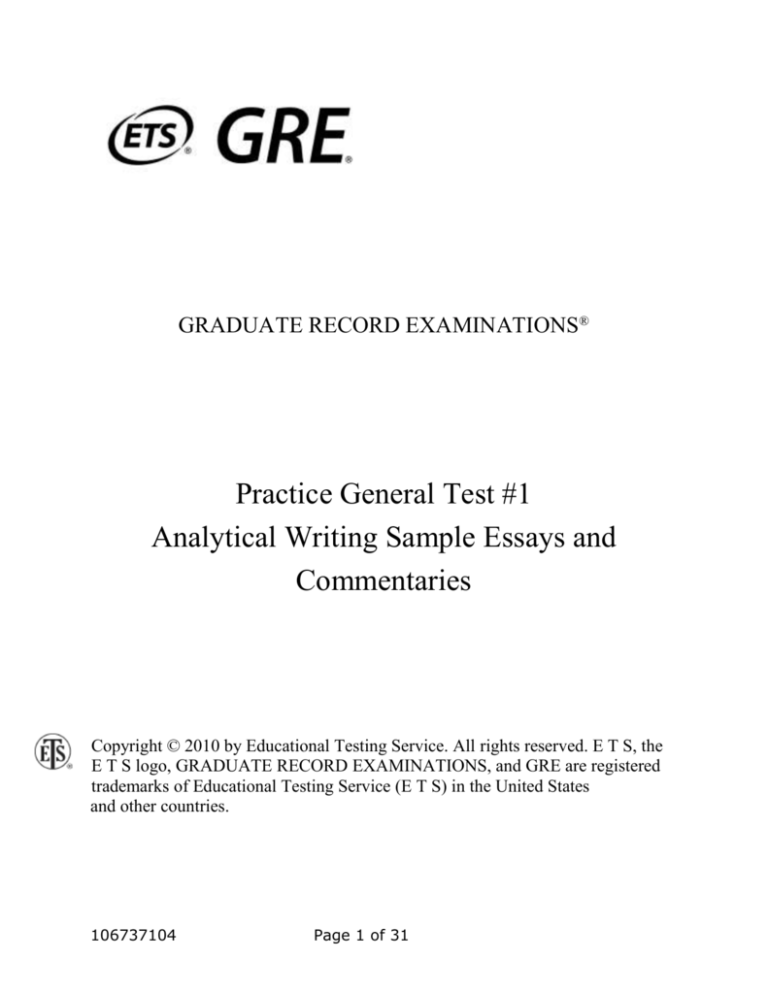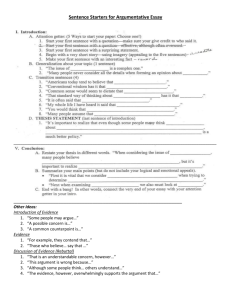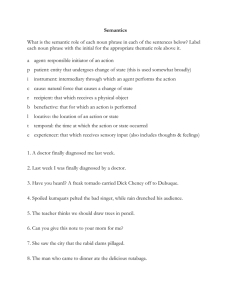
GRADUATE RECORD EXAMINATIONS®
Practice General Test #1
Analytical Writing Sample Essays and
Commentaries
Copyright © 2010 by Educational Testing Service. All rights reserved. E T S, the
E T S logo, GRADUATE RECORD EXAMINATIONS, and GRE are registered
trademarks of Educational Testing Service (E T S) in the United States
and other countries.
106737104
Page 1 of 31
Revised GRE® Practice Test 1.
Analytical Writing Sample Essays
with Commentaries.
Information for screen reader users:
This document has been created to be accessible to individuals who
use screen readers. You may wish to consult the manual or help
system for your screen reader to learn how best to take advantage of
the features implemented in this document. Please consult the
separate document, ScreenReaderIntro.doc, for important details.
The Analytical Writing portion of the GRE consists of two writing topics,
an Issue topic and an Argument topic.
Analyze an Issue
Sample Issue Topic Directions
Directions: The Analytical Writing portion of the GRE consists of two
writing topics: Analyze an Issue and Analyze an Argument. For this
section, Analyze an Issue will be the writing topic.
You will be given a brief quotation that states or implies an issue of
general interest and specific instructions on how to respond to that
issue. Plan and compose a response in which you develop a position on
the issue according to the specific instructions. A response to any
other issue will receive a score of zero. Standard timing for an issue
topic is 30 minutes.
106737104
Page 2 of 31
Make sure that you respond to the specific instructions and support
your position on the issue with reasons and examples drawn from such
areas as your reading, experience, observations, and/or academic
studies.
Trained GRE readers will read your response and evaluate its overall
quality according to how well you do each of the following:
Respond to the specific instructions on the issue
Consider the complexities of the issue
Organize, develop, and express your ideas
Support your position with relevant reasons and/or examples
Control the elements of standard written English
Before you begin writing, you may want to think for a few minutes
about the issue and the instructions and then plan your response. Be
sure to develop your position fully and organize it coherently, but
leave time to reread what you have written and make any revisions
you think are necessary.
Sample Issue Topic:
The best ideas arise from a passionate interest in commonplace things.
Discuss the extent to which you agree or disagree with the statement
above and explain your reasoning for the position you take. In
developing and supporting your position, you should consider ways in
which the statement might or might not hold true and explain how
those considerations shape your position.
The following are sample responses and commentary on those
responses, which explain how the response was scored. There are
106737104
Page 3 of 31
responses and scoring comments for essays with scores of 6, 5, 4, 3,
2, and 1.
Note: Sample responses are reproduced exactly as written, including
misspellings, wrong choice of words, typographical and grammatical
errors, etc., if any.
The following sample issue response received a
score of 6:
Passion is clearly necessary for a truly great idea to take hold among a
people—passion either on the part of the original thinker, the
audience, or ideally both. The claim that the most lucrative subject
matter for inspiring great ideas is “commonplace things” may seem
initially to be counterintuitive. After all, aren't great ideas usually
marked by their extraordinary character? While this is true, their
extraordinary character is as often as not directly derived from their
insight into things that had theretofore gone unquestioned. While
great ideas certainly can arise through seemingly pure innovation . . .
say, for example, Big Bang cosmology, which developed nearly all of
its own scientific and philosophical precepts through its own process of
formation, it is nevertheless equally true that such groundbreaking
thought was, and is, still largely a reevaluation of previous
assumptions to a radical degree . . . after all, the question of the
ultimate nature of the universe, and man's place in it, has been central
to human thought since the dawn of time. Commonplace things are,
additionally, necessary as material for the generation of “the best
ideas” since certainly the success among an audience must be
considered in evaluating the significance and quality of an idea.
The advent of Big Bang cosmology, which occured in rudimentary form
almost immediately upon Edwin Hubble's first observations at the
106737104
Page 4 of 31
Hooker telescope in California during the early 20th century, was the
most significant advance in mankind's understanding of the universe in
over 400 years. The seemingly simple fact that everything in the
universe, on the very large scale, is moving away from everything else
in fact betrays nearly all of our scientific knowledge of the origins and
mechanics of the universe. This slight, one might even say
commonplace, distortion of tint on a handful of photographic plates
carried with it the greatest challenge to Man's general, often religiously
reinforced, conception of the nature of the world to an extent not seen
since the days of Galileo. Not even Charles Darwin's theory, though it
created more of a stir than Big Bang cosmology, had such shattering
implications for our conceptions of the nature of our reality. Yet it is
not significant because it introduced the question of the nature of what
lies beyond Man's grasp. A tremendous number of megalithic ruins,
including the Pyramids both of Mexico and Egypt, Stonehenge, and
others, indicate that this question has been foremost on humankind's
collective mind since time immemorial. Big Bang cosmology is so
incredibly significant in this line of reasoning exactly because of the
degree to which it changed the direction of this generally held,
constantly pondered, and very ancient train of thought.
Additionally, there is a diachronic significance to the advent of Big
Bang cosmology, which is that, disregarding limitations such as the
quality of optical devices available and the state of theoretical math, it
could have happened at any point in time. That is to say, all evidence
points to roughly the same raw intellectual capacity for homo sapiens
throughout our history, our progress has merely depended upon the
degree of it that a person happens to inherit, a pace that has been
increasing rapidly since the industrial revolution. Yet this discovery had
to happen at a certain point in time or another—it cannot have been
happening constantly or have never happened yet still be present—and
this point in time does have its own significance. That significance is
precisely the fact that the aforementioned advent must have occurred
106737104
Page 5 of 31
at precisely the point in time at which it truly could have occured—that
is to say, it marks the point in our history when we had progressed
sufficiently to begin examining, with remarkable substantiated acuity,
the workings of the universe across distances that would take millions
of human lifetimes to reach or to traverse. The point for the success of
this advent must necessarily have been, additionally, the point at
which the audience concerned was capable and prepared to accept
such a radical line of reasoning.
Both factors, a radical, passionate interpretation of the commonplace
and the preparedness to accept such an interpretation, are necessary
for the formulation of a truly great idea. If the passion is absent from
an inquiry by the thinker or by the bulk of an audience, the idea will
die out if it comes to fruition at all. If the material is not sufficiently
commonplace to be considered by an informed audience of sufficient
size, the same two hazards exist. Given these two factors, the idea
must still be found palatable and interesting by the audience if it is to
hope to gain a foothold and eventually establish itself in a significant
fashion.
Comments on sample essay receiving score of 6:
This outstanding response presents a cogent, well-articulated analysis
of the complexities of the issue by arguing that (1) great ideas develop
from commonplace observations that are interpreted in a radical way;
and (2) passion is required of both thinkers and the audience in order
for great ideas to take hold.
The argument is based on an extended example (Big Bang cosmology)
and has two parts. The first part defines “commonplace things” as
universal questions (i.e., the quest to understand the cosmos is
commonplace, though complex, because it is an ancient and universal
106737104
Page 6 of 31
question) and places Big Bang cosmology in context with the scientific
breakthroughs of Galileo and the Pyramids of ancient Mexico and
Egypt. The second part explains Big Bang as the result of a
convergence of factors: both thinkers and the audience must be ready
to reevaluate “previous assumptions” and accept “radical, passionate
interpretations.”
The argument’s careful line of reasoning is strengthened by
appropriate transitions between paragraphs (“Additionally,” “Both
factors, a radical, passionate interpretation of the commonplace and
the preparedness to accept such an interpretation, are necessary for
the formulation of a truly great idea,” etc.) and within paragraphs
(“Not even Charles Darwin’s,” “Yet,” “that is to say,” etc.). Fluent and
precise language—advent, rudimentary, diachronic, shattering
implications, megalithic ruins—and effective sentence variety also
characterize this response as outstanding. Finally, despite the
presence of minor errors (overuse of comma and inconsistent use of
ellipses in paragraph 1), this response demonstrates facility with the
conventions of standard written English.
The following sample issue response received a
score of 5:
The statement above comes from the perspective that the best
thinkers, inventors, and innovators are the way that they are because
they explore passionately the interesting things around them. Yes, I
would say that this is definitely true. I understand best the things that
interest me, but it is only the things with which I am familiar with and
understand in my surroundings. It would be difficult to take passionate
interest in the things which I did not have available in my
environment.
106737104
Page 7 of 31
For example, let's consider some “idea” people in history. The person
who invented the basketball hoop, or the game of volleyball, or ice
skates, all had interest in those things before they had their brilliant
ideas. I do know that the inventor of the basketball hoop used to
coach a basketball team of young boys, and they would throw the ball
into a fruit basket that was nailed to the wall. Obviously, a basket has
a bottom to it, and they would have to fish it out after every successful
throw. So he had the brilliant idea of cutting out the bottom of the
basket. It seems so simple to us now, but nobody had ever played
basketball like that in his day.
The phrase, “commonplace things” can be rather misleading, I believe.
I think every person has slightly different “commonplace things” in
their environment depending on their interests, their financial status,
and availability of items. What is commonplace for one person may
never be known by another. I take passionate interest in things having
to do with sewing using patterns, fabrics and threads. However, my
mother and grandmother are excellent seamstresses and I had the
availability of learning from them. It was a “commonplace thing” for
me. I have had some wonderful ideas come out of my passion for this
kind of art.
Orville and Wilbur Wright had a passionate interest in things having to
do with flight, a rather ordinary thing for the sorts of birds who can fly
with their wings, but certainly not people. If I had lived during the
Wright brothers' time, I would probably not have had the same
passionate interest in figuring out how to make humans fly, because it
is not something that I would have thought possible. But their dreams
and visionary possibilities were much bigger than mine would have
been at that time. They not only had a passionate interest but they
were willing to experiment, to risk financial ruin and ridicule, and even
put their lives on the line. So while it is true that the best ideas arise
106737104
Page 8 of 31
from a passionate interest in commplace things, there also has to be
an element of daring to challenge “norms” and not being able to just
accept things as they are. There has to be a desire to make things
better and to improve on the present.
There also has to be the element of not being afraid of failure. Most
ideas do inevitably fail. Einstein is viewed today as being one of the
most brilliant thinkers and “idea” people in all of history. But nobody
really talks about how many times his ideas failed. The number is
quite amazing. Many people are afraid of failure, so even though they
make take a passionate interest in something commonplace, and have
some great ideas, they may never carry them through because of
uncertainty that they would work. We must be willing to try!
So, yes, it is true that the best ideas arise from a passionate interest
in commonplace things, because these are the things that we know,
these are the things that we understand, and the things that we want
to explore in even more depths. But there must be more elements
involved than just taking interest in something. We must be willing to
face risks of many kinds in order to separate the ideas that fail from
the ones that will triumphantly succeed.
Comments on sample essay receiving score of 5:
This strong response presents a well-considered analysis of the
complexities of the issue by arguing that great ideas come, not only
from a passionate interest in the commonplace, but also from great
imagination and a willingness to succeed.
The logic of the response unfolds very smoothly: paragraph 3 explores
the term “commonplace” and offers support for the prompt’s position;
paragraphs 4 and 5 discuss the related issues of imagination,
106737104
Page 9 of 31
willingness to experiment, and overcoming failure. The examples are
well chosen and generally well developed.
Paragraph 2 offers a relevant, though predictable, sports example
(invention of basketball hoop) to examine how commonplace
things/familiarity can spark great ideas. A personal example is used in
paragraph 3 to further explore the definition of “commonplace” and
illustrate how the term is relative to financial status and availability
(though only the concept of availability is developed in this example).
Paragraph 2 logically extends into paragraph 3, and the same
connection is seen between paragraphs 4 and 5. In paragraph 4 the
Wright brothers are used to argue that great ideas also come from
imagination and a willingness to experiment. The final example, in
which Einstein is offered to illustrate the necessity of overcoming
failure, is not as fully developed as the others. The respondent does
not explain what failures Einstein endured or how he overcame them,
which makes the example less compelling. Overall, the analysis
demonstrated in the examples is “perceptive and clear,” but not
“insightful and cogent” as required for a score of 6.
While the response expresses ideas clearly, using appropriate
vocabulary and sentence variety, it does not use language as fluently
and precisely as would a typical 6. Occasional wordiness/awkwardness
could be avoided with more precise diction (e.g., “There also has to be
the element of not being afraid of failure,” or “I have had some
wonderful ideas come out of my passion for this kind of art”).
The following sample issue response received a
score of 4:
106737104
Page 10 of 31
In agreement with the statement, many great inventions have come
from individuals interested in commonplace things. Out of simplicity
arises great ideas, and I would consider commonplace things to be
simplistic. However, it is hard to say that the “best” ideas arise from
passion in commonplace things, because one could argue that the best
ideas involve interest in remarkable things, which is what makes them
the “best” ideas.
If the statement is viewed from the standpoint of all ideas from the
beginning of civilization, then the statement holds true. Examples of
commonplace things are food and shelter. If a person had an
abundance of food and needed to transport it, they may have the idea
to weave a basket or make some sort of tote in order to load more at
once. With that idea, eventually the people would think of things to
make the first idea more useful, such as adding wheels to your
carrying device. With shelter, first people (Cro-Magnon)may have kept
out of weather and unsafe territory by using caves as shelter. From
passionate interest in the common shelter a person may have come up
with brilliant ideas about structures, architecture, and construction.
In concern with the opposing view that the best ideas arise from
remarkable things, one could argue that best ideas are medical
breakthroughs and all other aspects of Science. Working with
substances and molecules and creating ions and isotopes is not a
commonplace thing. However, it is what the people who make the
scientific breakthroughs have passionate interest in expanding.
Looking at the big picture, I would say that if people did not have
“passionate interest in commonplace things”, then the idea that led us
to the remarkable things would have never occurred. If that is true
then the statement holds true because the best ideas do arise from a
passionate interest in commonplace things. Though some older ideas
106737104
Page 11 of 31
may seem obsolete now, there was a time that without those ideas,
we would still be in the dark ages.
Overall, I agree with the statement. The best ideas do arise from a
passionate interest in commonplace things. Though I do not consider
medical breakthroughs coming from interest in commonplace things,
our species appears to be reaching the point in which cancer and AIDS
could be considered a commonplace thing. If that is true, then when
someone finds a cure for cancer or AIDS it will be one of the best ideas
arising from a passionate interest in a commonplace thing. Once again
reinforcing the truth of the statement.
Comments on sample essay receiving score of 4:
This response presents a competent analysis and conveys meaning
adequately.
Paragraph 2 offers appropriate and adequately developed examples
from “the beginning of civilization” to illustrate how commonplace
needs inspire innovation: the need to transport food led to the
invention of woven baskets and, eventually, the invention of the
wheel; similarly, the need for shelter that drove “Cro-Magnon” to the
caves eventually inspired “brilliant ideas about structures, architecture,
and construction.”
Paragraph 3, which explores the “opposing view” (the best ideas arise
from remarkable things), is less developed. The respondent claims
that the best ideas are “medical breakthroughs and all other aspects of
Science,” without explaining what is meant by “Science” or why these
types of ideas are the “best.” Does “Science” include engineering,
computer sciences, and the social sciences? Why are advances in
science and medicine better than advances in religion, the arts, or
106737104
Page 12 of 31
philosophy? The response also fails to acknowledge the commonplace
interests (e.g., desire to improve quality of life) that drive
medical/scientific research. While the response addresses two sides of
the issue, it never delves into complexity the way a 5 or 6 would.
In paragraph 4 the response comes to a new conclusion: without initial
interest in commonplace things, interest in remarkable things would be
impossible. This is an interesting position that, if developed and
supported with well-chosen examples, could lead to complex analysis.
However, the conclusion is merely stated, loosely supported with
generalities, and then further confounded by shaky logic in paragraph
5.
Ideas are expressed with reasonable clarity and the response generally
demonstrates control of language. It is lack of complexity and logical
development that keep this response from earning a higher score.
The following sample issue response received a
score of 3:
How do new knowledge came into being? Sometimes it stemed from
exsiting knowledge. Sometimes it was born all out of sudden. Both
ways seem work well. As I see through this question, I believe that
what plays a key role in creating new ideas is a passionate interest.
Throughout history, a myriad of examples help prove the importance
of interest. Edison, the greatest inventors in the world, posessed a
sharp interest ever since his childhood. In his eyes, every common
things were full of mysteries. It was his unique interest which helped
him look into the machanism of things around therefore new iders
came into his mind and, changed into conceret machines facilitating
106737104
Page 13 of 31
our lives. Another famous example is that of Newton. A riped apple
from a tree fell onto his head one afternoon. For ordinary people, this
kind of trivial instance would slip off their mind at once. However,
Newton lost hisself in thought of the relation between objects. Finally
he found gravitation and opened up a new era of physics.
On the other hand, without interest, the opportunity of great
discoveries will pass by. Most people are experiencing ordinary lives
everyday. Why don't they come up with great ideas? Because interest
is a state of skeptism, a state in which we do not stop to disclose the
truth beneath a surface of commonplaces. Interest means the ability
to explore the internal corelations. Therefore, with a passiontae
interest, those commonplace things are no longer commonplace, and
new ideas are created.
From what have been discussed above, we can see that interest serves
as force to propell the exploration of unknowns, to perfect the
structure of human knowledge, and to move towards the ultimate
truth.
Comments on sample essay receiving score of 3:
This limited response demonstrates some competence in its analysis
and in conveying meaning but is obviously flawed.
The response agrees with the prompt by arguing that a passionate
interest allows people to see beyond the commonplace and create new
ideas (paragraphs 1 and 3). However, the response is limited in
presenting and developing this position.
In paragraph 2 the response offers two relevant but underdeveloped
examples to illustrate the importance of interest in generating ideas.
106737104
Page 14 of 31
The Edison example is not persuasive because its development is
limited to generalities (“common things were full of mysteries . . .
which helped him look into the machanism of things . . . therefore new
iders came into his mind and, changed into conceret machines”). The
response does not provide specific examples of the common “things”
that interested Edison, nor does it discuss any of Edison’s particular
ideas. Thus, it does little to advance the response’s position. The
Newton example is not penalized for historical inaccuracy. However,
like the previous example, it is overly general and underdeveloped.
The response also contains an accumulation of language errors (in
usage, word choice, and sentence structure) that often result in a lack
of clarity. For instance, the rhetorical device used in paragraph 1
contains frequent errors that render it ineffective. The imprecise
language use in the Newton example is particularly unsettling:
“Newton lost hisself in thought of the relation between objects. Finally
he found gravitation and opened up a new era of physics.” While these
errors do not generally interfere with meaning, they constitute a lack
of language control that precludes a score of 4.
The following sample issue response received a
score of 2:
The above statement reinforces my values and beliefs. I agree that the
best ideas arises from a paasionate interest. I agree simply because a
person must be able to personally relate to a thing in order to become
passionate to the idea. The person behind the best ideas are
passionate because the commonplace things have affected the person
on a personally level or on a mutual level. The relationship between
the commonplace thing and the best idea unites a passionate interest
106737104
Page 15 of 31
to the person who it has affected. A person must have a desire to build
on their passion in order to follow through on his or her idea.
Comments on sample essay receiving score of 2:
This response presents a seriously flawed analysis of the issue.
The response agrees with the prompt by arguing that a person must
be able to relate to something in order to develop passion for it. (The
connection between things one can “relate to” and “commonplace
things” is implied.) The response also states that passion is necessary
in order for a person to follow through on an idea. However, neither of
these claims is supported with relevant reasons or examples.
Furthermore, flawed word choice and other language control problems
make the reasoning hard to follow (particularly in sentences 4 and 5:
“The person behind the best ideas are passionate because the
commonplace things have affected the person on a personally level or
on a mutual level. The relationship between the commonplace thing
and the best idea unites a passionate interest to the person who it has
affected.” In those sentences the respondent attempts to analyze the
relationship between commonplace things, passion, and ideas).
Nevertheless, this response is not a 1: the respondent does provide
evidence of the ability to understand the issue and attempts to present
a position on it.
The following sample issue response received a
score of 1:
106737104
Page 16 of 31
This topic can be found to be true in many different areas. The best
ideas that people have come up with are usually founded be improving
commonplace things. For example in order to improve the effiecency
of writing the typewriter was invented, then following that the
computer was invented.
Comments on sample essay receiving score of 1:
This response presents a fundamentally deficient discussion of the
issue.
The first sentence consists of generic language that can be applied to
any prompt. Thus, it neither enhances nor detracts from the analysis.
The remainder of the response consists of a statement in support of
the prompt and a list of two examples (the typewriter and the
computer). The examples offered are potentially relevant but
completely undeveloped. Basic errors in usage and grammar are
pervasive, but it is primarily the inability to develop an organized
response that makes this response a 1.
This is the end of sample responses and commentaries for the Issue
task. Sample responses and commentaries for the Argument task
follow.
106737104
Page 17 of 31
Revised GRE Practice Test 1.
Analyze an Argument
Sample Argument Topic Directions
Directions: The Analytical Writing portion of the GRE consists of two
writing topics: Analyze an Issue and Analyze an Argument. For this
section, Analyze an Argument will be the writing topic.
You will be given a short passage that presents an argument, and
specific instructions on how to respond to that passage. Plan and
compose a response in which you analyze the passage according to
the specific instructions. A response to any other argument will receive
a score of zero. Standard timing for an argument topic is 30 minutes.
Note that you are NOT being asked to present your own views
on the subject. Make sure that you respond to the specific
instructions and support your analysis with relevant reasons and/or
examples.
Trained GRE readers will read your analysis and evaluate its overall
quality according to how well you do each of the following:
Respond to the specific instructions on the passage
Identify and analyze important features of the passage
Organize, develop, and express your analysis
Support your analysis with relevant reasons and/or examples
106737104
Page 18 of 31
Control the elements of standard written English
Before you begin writing, you may want to think for a few minutes
about the passage and the instructions and then plan your response.
Be sure to develop your analysis fully and organize it coherently, but
leave time to reread what you have written and make any revisions
you think are necessary.
Sample Argument Topic:
The argument to be analyzed is as follows:
Hospital statistics regarding people who go to the emergency room
after roller-skating accidents indicate the need for more protective
equipment. Within that group of people, 75 percent of those who had
accidents in streets or parking lots had not been wearing any
protective clothing (helmets, knee pads, etc.) or any light-reflecting
material (clip-on lights, glow-in-the-dark wrist pads, etc.). Clearly, the
statistics indicate that by investing in high-quality protective gear and
reflective equipment, roller skaters will greatly reduce their risk of
being severely injured in an accident.
Write a response in which you
examine the unstated assumptions of the argument above
and
explain how the argument depends on the assumptions and what
the implications are if the assumptions prove unwarranted.
The following are sample responses and commentary on those
responses, which explains how the response was scored. There are
106737104
Page 19 of 31
responses and scoring comments for essays with scores of 6, 5, 4, 3,
2, and 1.
Note: Sample responses are reproduced exactly as written, including
misspellings, wrong choice of words, typographical and grammatical
errors, etc., if any.
The following sample argument response received
a score of 6:
The argument above is well-presented and appears to be relatively
sound at first glance: because of the hospital statistics regarding
people who go to the emergency room after roller-skating accidents,
the roller skaters should investing in high-quality protective gear and
reflective equipment in order to reduce their risk of being severely
injured in an accident. However, as more light is shed on the issue and
more detailed facts are concerned, it is easy to see that the argument
suffers from several grave fallacies in its assumptions as well as
commits a false analogy.
To begin with, as mentioned in the argument, there are two distinct
kinds of gear—preventative gear, such as light reflecting material, and
protective gear, such as helmets. Preventative gear is intended to
warn others, presumably for the most part motorists, of the presence
of the roller skater. It works only if the “other” is a responsible and
caring individual who will afford the skater the necessary space and
attention. Protective gear is intended to reduce the effect of any
accident, whether it is caused by another, the skater or some force of
nature. Protective gear does little, if anything, to prevent accidents but
is presumed to reduce the injuries that occur in an accident. The
statistics on injuries suffered by skaters would be more interesting if
106737104
Page 20 of 31
the skaters were grouped into those wearing no gear at all, those
wearing protective gear only, those wearing preventative gear only
and those wearing both. These statistics could provide skaters with a
clearer understanding of which kinds of gear are more beneficial.
In addition, the argument is much weakened by the fact that it does
not take into account the inherent differences between skaters who
wear gear and those who do not. It is at least likely that those who
wear gear may be generally more responsible and/or safety conscious
individuals. The skaters who wear gear may be less likely to cause
accidents through careless or dangerous behavior. It may, in fact, be
their natural caution and responsibility that keeps them out of the
emergency room rather than the gear itself. Also, the statistic above is
based entirely on those who are skating in streets and parking lots
which are relatively dangerous places to skate in the first place. People
who are generally more safety conscious may choose to skate in safer
areas such as parks or back yards.
Moreover, the statistic also can not make sense when come to the
conclusion that safety gear prevents severe injuries. The conclusion
suggests that it is presumed that people come to the emergency room
only with severe injuries. This is certainly not the case. Also, given
that skating is a recreational activity that may be primarily engaged in
during evenings and weekends when doctors' offices are closed, skater
with less severe injuries may be especially likely to come to the
emergency room for treatment.
Last but not least, there is absolutely no evidence provided that high
quality gear is any more beneficial than other kinds of gear. For
example, a simple white t-shirt may be easily catched by others' sight
that provide the same or even more preventative benefit as a higher
quality, more expensive, shirt designed only for skating. Before
skaters are encouraged to invest heavily in gear, a more complete
106737104
Page 21 of 31
understanding of the benefit provided by individual pieces of gear
would be helpful.
Overall, the argument is far from forceful enough to persuade the
roller skaters should invest in high-quality protective gear and
reflective equipment in order to reduce their risk. Before any final
decisions are made about whether the roller skaters should invest in
high-quality protective gear and reflective equipment, much work is
left for the arguer to do to make his/her argument more logical and
cogent.
Comments on sample essay receiving score of 6:
This outstanding response presents a comprehensive examination of
the argument’s root flaws. Specifically, the response exposes several
points that undermine the argument:
that preventative gear and protective gear are not the same
that skaters who wear gear may be less prone to accidents
because they are, by nature, more responsible and cautious
that the statistics do not differentiate by the severity of the
injuries
that gear may not need to be high-quality to be beneficial
The discussion is smoothly and logically organized, and each point is
thoroughly and cogently developed. In addition, the writing is succinct,
economical, and contains few minor errors. Sentences are varied and
complex, and the diction is expressive and precise.
In sum, this response exemplifies a score of 6 because it presents
cogent, well-articulated critique and conveys meaning skillfully.
106737104
Page 22 of 31
The following sample argument response received
a score of 5:
This argument is too weak to be convincing, relying on the correlation
of two incomplete statistics. Correlation does not always imply
causation, though it might be tempting to believe it is. Here, the
implication is that protective gear will reduce the risk of accident. It
assumes that lack of protective gear is the main cause of severe injury
in roller skates, which is not necessarily true under any circumstance.
First, it claims that 75 percent of roller-skaters who have had
accidents in streets or parking lots were not wearing any protective
gear. This says nothing about the cause or the degree of severity of
injuries. Some may have been hit by vehicles in broad daylight, in
which case neither padding nor reflective material would have saved a
skater. Common sense dictates that padding will reduce your risk of
being injured, but in extreme cases, padding may do very little.
The argument also ignores the fact that roller-skating is something of
an “extreme sport.” While the injured may have been injured with
roller skates on the street or in a parking lot, the injuries may have
resulted from the skater's predilection for performing dangerous tricks.
Often, these tricks involve careful balancing on thin objects while
moving at high speed, and it is questionable how much padding would
protect a skater. One would need to compare this to the statistics of
injuries occurring in skate parks.
Lastly, the last 25 percent of emergency room cases of this type are
also ignored. What would be useful are the types of injuries incurred
on these people as a basis of comparison. They may all have been
injured so severely that they are forced into extended hospital stays.
By the same argument as given above, 100% of all skaters wearing
106737104
Page 23 of 31
protective gear suffered extreme injuries, thus it is imperative that
skaters not wear any such accessories at all.
The use of statistics is a shaky way of bolstering an already decent
argument. There are too many implications derived from the data the
way it is presented. As such, the numbers are an indirect method of
supporting the need for more protective accessories in skating. The
argument could be improved by providing more statistics detailing the
nature of injuries and a better representative group with which to
compare data. One simply cannot compare injuries caused by
carelessness or recklessness as opposed to general accidents, at least
not statistically, as carelessness will improve the chances of injury. As
it stands, the argument has too many holes with which it can be torn
apart.
Comments on sample essay receiving score of 5:
This strong response sets out to critique the argument’s use of
statistics and its assumption that lack of protective gear causes more
severe injuries, and it does just that. The response identifies and
critiques insufficiencies of the statistics that cause the argument to be
less than compelling:
that the statistics do not differentiate between the causes or
severity of the injuries
that the statistics only represent people who skate in parking lots
and streets, and that these people may engage in more
dangerous activities than those who skate in skate parks
that no information is given about the extent of the injuries for
the other 25 percent who were wearing protective gear, and that
their injuries might have been comparable to or worse than those
who did not wear gear
106737104
Page 24 of 31
The respondent develops each of these points by offering alternative
explanations and, in paragraphs 2 and 3, by calling for additional data
that would be needed to confirm or refute the argument’s
assumptions. The response does not analyze the argument as
insightfully or develop its critique as fully as required for a 6, but the
clear organization, strong control of language, and substantial degree
of development warrant more than a score of 4.
The following sample argument response received
a score of 4:
This argument is based on the claim that investing in high-quality
protective gear and reflective equipment, roller skaters will reduce the
risk of being severly injured in an accident. This is based on a stastic
that states that 75 percent of the people who go to the emergency
room after a roller-skating accident had not been wearing any
protective clothing or light-reflecting material. However, this
argument makes many assumptions which weaken the argument as a
whole.
First, the argument assumes that the people who went to the
emergency room after roller-skating injuries were skating properly.
The accidents could have been avoided if the skaters were following
skating rules, such as where to skate and obeying laws of traffic. Any
violations to these skating rules could have been the reason the
skaters were injured. However, the argument fails to address this
issue, which makes it unsound.
Second, the argument assumes that the skaters who were injured did
not take any abnormal risks. The accidents could have occured
106737104
Page 25 of 31
because of the risks taken by the skaters. Readers do not know if the
statistics were collected from a representative sample. The data could
have been collected from a group of young males who tend to take
risks greater than those of older women, but the argument does not
address this issue. The argument assumes that the statistics sample
the population accurately, which provides weakness to this argument.
Last, the argument assumes that protective equipment will solve the
problem of sever roller-skating injuries. In actuality, the assumptions
that the argument makes prior to this assumption creates a great deal
of skepticism for readers. There are many external factors that were
not addressed in this argument and that would alter the conclusion if
they were considered. It weakens the argument to assume that the
addition of protective gear would directly reduce the risk of being
severely injured in an accident.
For all these reasons, the argument can be viewed as fundamentally
unsound. The argument could be strengthened by addressing whether
or not the skaters followed rules and laws effecting skating. It could
be strengthened by identifying the risks taken by the skaters from
which the data was collected. And the argument could be greatly
stengthened by eliminating any external forces or addressing them in
the argument. All of these adjustments would provide the agrument
with a solid foundation.
Comments on sample essay receiving score of 4:
This response presents a competent critique of the argument and
conveys meaning adequately.
After paraphrasing the argument in paragraph 1, the respondent
analyzes some questionable assumptions:
106737104
Page 26 of 31
that skaters who went to the emergency room had been skating
properly and obeying traffic laws
that skaters who went to the emergency room did not take any
abnormal risks
that statistics were collected from a representative sample
that protective equipment will solve the problem of severe rollerskating injuries
At first glance, the response appears well organized and each point
seems equally developed. However, it is not clear that “skating
properly” and “not tak[ing] any abnormal risks” are two separate
issues as suggested by the organization of the response. Rather than
organizing information logically, the respondent attempts to fit the
critique into a formulaic package. In addition, the discussion in
paragraph 4 offers little in the way of analysis, instead relying on
empty generalities. Despite appearances, discussion of the points
listed above is only adequately developed and competently presented.
The response is not thorough or thoughtful enough to merit a score of
5.
The writer's general control of language also supports a score of 4. The
paper is free of significant or persistent errors. Diction is apt and
sentence construction is generally skillful.
The following sample argument response received
a score of 3:
In many roller skating accidents the person injured is not wearing
appropriate protective equipment. The statement assumes that the
cause of the accident was the injured persons lack of high-quality
106737104
Page 27 of 31
protective gear and reflective equipment. The statment does not
address the fact that accidents can occur and injuries may result even
if a person does have the appropraite high-quality protective gear and
reflective equipment.
The hospital statistics does show that 25% of those injured in rollerskating accidents in a street or parking lot were wearing some form of
protective clothing although they were still injured. This shows that
their is a 1 in 4 chance that someone wearing protective equipment
will stil be injured if involved in an accident. The arguement depends
purely on assumptions that the accidents that roller-skaters are
involved in are minor and not life threatening. The their was a greater
amount of life-threateing injuries such as roller-skater verses
automobile, the fact that they wore protective equipment would be of
little help to the injured person.
More analysis would need to be done before deciding if the highquality protective gear and reflective equipment would greatly reduce
the risk of being severly injured in an accident. One must consider
what types of accidents roller-skaters are most likely to get into and
weither they would be injured despite the fact that they wear
protective equipment.
Comments on sample essay receiving score of 3:
This response demonstrates some competence in its critique of the
argument and in conveying meaning but is obviously flawed.
This response suffers from poor reasoning, both in its interpretation
and in its criticism of the argument. First, the response misstates the
argument’s conclusion in paragraph 1: “The statement assumes that
the cause of the accident was the injured persons lack of high-quality
106737104
Page 28 of 31
protective gear and reflective equipment.” From this faulty reading of
the prompt, a slew of illogic progresses.
The response focuses its critique on the 25 percent of skaters who
suffered injuries despite having worn some type of protective or
reflective equipment. From this fact, the respondent draws a faulty
conclusion that there is a 1 in 4 chance that someone wearing
protective equipment will still be injured in an accident. Even if that
followed from the original statistics, the respondent does not explain
how such a fact weakens the argument.
In the end the response does offer two potentially relevant points of
criticism:
that the type of injuries is not addressed
that the type of accidents is not addressed
However, these points are undeveloped; the response calls for more
information about types of accidents and injuries but does not explain
how such information would strengthen the argument.
There are a few minor errors in writing. However, it is lack of
development and poor reasoning that force a score of 3.
The following sample argument response received
a score of 2:
The judgement is questionable. First, the the statistics focus on the
protective equipment of rollerskating, but it shows us that statistics in
streets or parking lots. Isn't it strang? whether the equipment is useful
or not should be test in the rollerskating field.
106737104
Page 29 of 31
Second, the statistics only show the 75 percent of people who go to
the emergency room without protective equipment, but how about the
people who wear equipment. Maybe the people with protective
equipment become careless and they are dead in accidents, so they
are not counted in these statistics.
In order to make consummer believe the use of the protective
equipments, the satistics should show the injure population with and
without equipments and the noninjure pepulation with and without
equipments. Moreover, it should divide the injure conditions. There is a
large different from bone break and skin break.
Finally, without more detailed, I do not think the judgement is correct.
Comments on sample essay receiving score of 2:
This response demonstrates serious weaknesses in analytical writing.
The response attempts critique based on logical analysis but fails to
provide reasonable development.
The response offers three other points of critique:
the statistics are “questionable” because they only represent
skaters who skate in the street or parking lots (“it shows us that
statistics in streets or parking lots. Isn’t it strang?”)
the statistics are misleading because they do not include skaters
who have died while wearing protective equipment
the statistics should differentiate between type of injuries (“it
should divide the injure conditions”)
106737104
Page 30 of 31
While these are valid points of critique (that are often used in more
successful responses), this response fails to provide relevant and
reasonable support for them. In addition, this response has serious
problems in the use of language and sentence structure that interfere
with meaning (see examples above).
The following sample argument response received
a score of 1:
If the assumptions contained within this arguement are true then it
could be correlated that not only would protective gear assist in
reducing injury occurance amongst rollerbladers but could also initiate
city code to enforce such gear to be worn. If the arguement is a
falsehood and the injury could be conected more to the time of day
injury occured or even the sport itself then there will no change in the
injury occurance rate.
Comments on sample essay receiving score of 1:
This fundamentally deficient response offers two hypothetical
scenarios: what would happen if the argument were true; and what
would happen if the argument were false. There is no evidence of an
ability to understand or analyze the argument. In addition, each of the
two sentences contains minor errors in grammar. However, it is
primarily the lack of critique that forces a score of 1.
This is the end of Revised GRE Practice Test 1. Analytical Writing
Sample Essays with Commentaries.
106737104
Page 31 of 31







